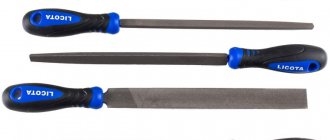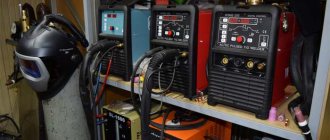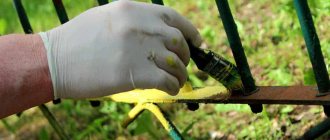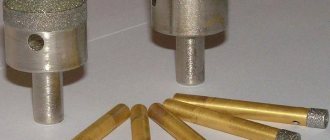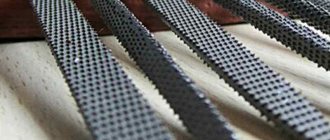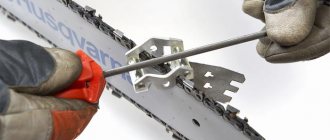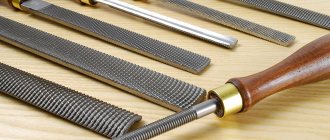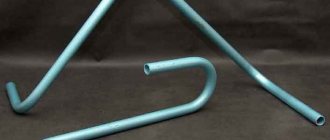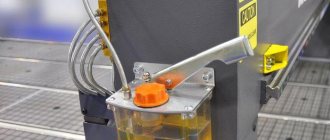A rasp file with a characteristic ribbed surface is similar in appearance to a rasp, but they are two different metalworking tools. It is easily recognized by its frequent raised notch, usually 12 or up to 5 teeth per unit area. The form can be of the following types:
- flat;
- semicircular;
- figured.
The main task of this device is to quickly and deeply remove the top layer of metal and set the shape of the workpiece. Without equipment with a garnish notch, it is impossible to move on to the next stage - processing with smaller, velvety teeth.
Definition and purpose of files
This name is given to a large group of tools designed to work with metal. When producing them, GOST must be taken into account. Among the features we note the following:
- The working part is represented by a metal part with notches. In this case, the form may differ significantly.
- A metal rod is attached to the handle.
Download GOST 1465-80
Due to the notches during the reciprocating movement, metal processing occurs, chips are formed, which are then removed.
How to choose a file
When choosing a certain type of hand file, professionals recommend paying attention to the materials processed and performance characteristics. Among the significant parameters is the quality of the teeth
Among the significant parameters is the quality of the teeth.
The efficiency of work directly depends on it.
In addition, it is worth considering:
— Type of notches; — Shape of the working fluid; — Length; — Features of the handle or shank.
Read also: Do-it-yourself cross stop for a circular saw
The dimensions must correspond to the dimensions of the parts being processed.
For large parts, use the maximum length - from 22 to 350 mm, and for small parts - from 150 to 180 mm.
The handle should be reliable and comfortable.
Wooden handles are considered less reliable; plastic and rubber are more convenient.
Also, tools are often offered without a handle.
Indicators such as the distribution of hardness and viscosity are very important.
Viscosity is minimum at the surface and maximum at depth, while hardness is the opposite.
Insufficient hardness leads to a rapid loss of tooth sharpness, and low viscosity threatens the destruction of the notch during operation.
Surface hardness is regulated depending on the purpose.
The average figures for manufacturers are the following values for files of various types:
1. Carpentry and metalworking purposes – from 64 to 66 HRc;
2. Grinding type – from 65 to 67 HRc;
3. Rasps – from 53 to 56 HRc.
The actual quality is only verified during use.
Operating principle
A modern bastard file is quite easy to use. The operating principle is as follows:
- The surface has indentations, the protrusions become a kind of cutting edge.
- At the moment of reciprocating movement, material is removed from the surface. The special shape determines that the chips fall into small recesses and are then removed.
The principle of operation is quite simple; the use of special alloys can significantly increase the service life.
Types of files for metal
There are various files for metal. Classification is usually carried out according to the following criteria:
- Sizes. The working part can have a variety of sizes. The choice based on this indicator is made depending on the area of the surface being treated. The recommended length is 15 cm longer than the product being processed. As for the width, as it increases, the load that must be transmitted increases significantly. The thickness of the metal must be decent, since otherwise, when force is applied, the plate can be seriously deformed. Attention is paid to products from well-known manufacturers, as they often have the most optimal characteristics.
- The type of material used when creating the main part. The use of conventional alloys is not allowed, as they will not withstand the load. Preferably, models made of hardened tool steel are selected. It can withstand quite long periods of use under difficult conditions. Alloy alloys are characterized by increased resistance to moisture, so corrosion does not appear on the surface over a long period.
- The type of material used in the manufacture of the handle, as well as its shape. At the time of work, you have to apply quite a lot of force. To do this, the handle must have a comfortable shape. At the time of purchase, you should take a bastard file in your hand and check how comfortable it will work with it.
- According to the shape of the working part. The classification is very extensive, the most common are flat, round and semicircular shapes.
- By the number of notches and their location relative to each other.
There are a wide variety of garnish file options available on the market, so there can be quite a lot of problems with the choice. The first thing people pay attention to is the shape of the working part. The installed handle should be comfortable; it is often made using plastic or hard wood.
DIY file handles
Real craftsmen equip their existing tools with handles made by themselves. With the advent of plastics, there was a wider choice of materials for homemade products.
If you have a lathe, then the handle can be turned from hardwood: walnut, birch, ash. There are quite a lot of drawings on the Internet, using which a suitable handle is made.
Some craftsmen use epoxy resin to make unusual handles.
- First, possible porous materials that can be impregnated with epoxy resin are selected. Most often, fabrics of different colors are used. Micarta is created - a multi-layer fabric impregnated with epoxy.
- They are placed in the desired sequence.
- The epoxy resin is diluted according to the attached recipe.
- Wet each layer.
- Lay in the chosen sequence and place under a press.
- After polymerization is completed, a new material is formed - micarta.
- A file handle is made from micarta.
Video: “Cuban” files.
Classification of tools by shape
Before carrying out the actual work, you should correctly select the most suitable tool. Today the following types of forms are found:
- Flat ones are much more common than others. Their main purpose is to file the external and internal surfaces of various products. The working part in this case is represented by a flat sheet of metal, which has notches on both sides. In some cases, notches are also applied to the end surfaces.
- Semicircular shapes are also often used to work with various products, as well as to obtain curved planes. At the same time, there is a reverse side, which is made in a flat form. The semicircular shape is used for cutting sharp corners, the index of which is 60 degrees.
- Sets often include a product with a round shape. They are applicable in cases where a semicircular bastard file cannot be used for one reason or another.
- There are square-shaped bastard files on sale. This design option is most convenient to use when working with narrow planes that cannot be processed using the standard version.
- Triangular ones are used to obtain sharp corners. In this case, the outer and inner surfaces can be processed.
- The diamond shape is used for filing teeth, which are the working surface of sprockets and gears. They are used extremely rarely, since gears and sprockets are part of rather complex mechanisms.
This classification should be taken into account when choosing a suitable garnish file. The above information indicates that the shape largely determines the scope of application.
Purpose and description of the tool
The main area of application for such tools is the processing of metal and other workpieces. The list of works for them includes several operations:
- Cleaning various surfaces from stubborn dirt and rust.
- Rough and final polishing.
- Refining the product to final dimensions.
- Grinding of impact areas, cuts, burrs, welds.
- Cleaning oxidized contacts.
- Sharpening teeth of saws and hacksaws.
Such work is carried out by contacting the edges of the device with applied notches and the surface of the material being processed. By increasing the pressing force, the number of movements and the speed of movement of the file, the depth of processing can be increased.
There are many varieties of such tools and each is used for specific needs. Using a file for other purposes impairs the quality of processing and reduces its service life.
Everyone knows what files there are. Over many years of use, the appearance of the device and its area of use have not changed dramatically. Even in modern high-tech enterprises, a lot of work on the final finishing of products is carried out with files.
At its core, a file is a cutting tool that looks like a steel billet with notches and a mounted handle or a pointed end for it. It can be made of wood or plastic and is included in the design to ensure a convenient and safe working process.
The bulk of such instruments have a rectangular, triangular or round shape, but other types are not excluded.
Purpose
In most cases, product processing is carried out in several stages. The use of such technology allows you to achieve better results, but a larger set of tools is required. Brushed files are used for rough metal processing. Among the features we note the following:
- A hog file is designed to remove metal whose layer is at least 0.25 mm.
- Depending on the specifics of a particular case, the allowance for the layer to be removed with a wormwood file can vary from 0.5 to 1 mm.
The above information indicates that the product is intended for rough surface finishing. After this, finishing sawing is carried out, due to which the required quality is achieved.
Do not forget that if you immediately carry out work with a brute file, which is intended for finishing, you can quickly ruin it.
That is why experts recommend removing metal exclusively in stages, starting with the use of a hog file.
Using a needle file
Only proper use of a needle file can significantly extend its service life. Among the recommendations we note:
- Do not treat over an oil stain; contact with lubricants is prohibited.
- Do not forget that the product is not designed to withstand high mechanical stress.
- It is worth considering that processing hard alloys, if the working part is not intended for this, leads to rapid wear of the cutting edges. Alloys that are too soft can cause chips to clog.
After using the tool, you should clean it. In addition, it is prohibited to place a file on metal parts or apply impact loads. Even a minor chip causes a significant reduction in service life and basic qualities.
Subtleties of tool selection
The information above indicates that there are simply a huge number of different types of bastard files on sale. In this case, the classification is carried out according to the shape of the notches, their length and the size of the main part. Recommendations for choosing a bastard file include the following:
- For soft alloys such as brass, aluminum and copper, the single cut design is suitable. In such a case, it is not recommended to use velvet tools, since the space between the notches quickly becomes clogged with soft shavings.
- When choosing, pay attention to the notch number. It must correspond to the thickness of the material being removed in one pass.
- The choice is also made based on what surface quality should be achieved. Roughness is a determining factor; it is indicated in the technological map for the production of the part.
- The length of the working part can also vary over a fairly wide range. The choice of a garnish file based on this parameter is quite simple: the larger the area being processed, the greater the length of the product should be. This ensures the required performance. It is recommended to add another 15 cm to the length indicator.
In addition, do not forget that a variety of alloys can be used in the production of the main part. The most commonly used tool steel is characterized by increased wear resistance. Products that are made from various alloy alloys have become widespread; the addition of certain chemical elements increases hardness and other performance characteristics.
Stage 1: determination of steel grade
Having selected used tools (needles, files, rasps, braids, etc.), first of all you should determine what grade of steel they are made of. To keep your search as limited as possible, you should know what types of steel a particular tool is made from. Thus, files can be made of both tool carbon steel (U10, U11, U12, U13) and alloy steel (ShKh6, ShKh9, ShKh15). You can learn more about this from the list of tools below. The files presented in the KovkaPRO assortment are made of high-alloy steel with a hardness of 64-66HRC
Products made of tool and alloy steel:
Files - U10, U11, U12, U13, ШХ6, ШХ9, ШХ15 Needles - U10, U11, U12 Rasps - U7, U7A Scrapers - U10, U12 Chisels, chisels - U7, U8 Taps - U10, U11, U12, P9, 9ХС , Р18 Drills for wood - 9ХС Metal drills -Р9, Р18 Reamers - Р9, Р18, 9ХС Mills - Р9, Р18 Chisels, screwdrivers - У7А, У8А, 7ХФ, 8ХФ Punches - У8, У8А Punch holes - У7А, 7ХФ, 8ХФ Sewing needles - U7A, U8A Hacksaw saws - U8GA Bow saw blades - U8GA, U10 Hacksaw blades - U8, U8A, U9, U9A, U10, U10A, U11, U12 Metal shears - U12A Hammers and sledgehammers - U7, U8 Axes - U7 Scythes, sickles – U7, U8 Forks, teeth (peckers) – U7, U8 rake Blacksmith tools – U7, U8
Safety first
Do not forget that when working with files you must follow safety precautions. The main recommendations are the following:
- Do not allow a quarrel file to hit the handle. This is due to the fact that in such a case the wear of the fastening increases and the product will not be able to serve for a long period. In addition, in such a case, there is a possibility that the handle will slip and the hand may be injured.
- It is prohibited to place your fingers on the cutting part during processing. When reciprocating, you can injure your hand on the sharp edges of the workpiece.
- Do not remove chips from the surface with bare hands. This is due to the high probability of skin damage. It is also forbidden to blow away chips, since due to the turbulence of the air cover, they can get into the eyes. For such a procedure there must be a special brush.
In addition, it is prohibited to carry out processing when using a garnish file with obvious surface or structural defects. This is because such a situation may cause damage to the workpiece or injury.
Features and scope of application of the rasp
In carpentry, a separate type of file called a wood rasp is often used. At first glance, these two tools are similar, but there are serious differences between them. The fact is that the notch of the rasp is made in the form of separate burrs of different shapes. Thanks to this configuration, the tool does not clog and can quickly process a large surface.
Note! A rasp is indispensable in cases where it is impractical to use other methods of surface treatment (saw, plane).
For example, you need to remove a few millimeters from the end surface of a small board. The saw will most likely ruin the workpiece, it is impossible to use a plane due to the short length of the board, a simple file will take a long time to work, and besides, it will constantly become clogged with sawdust.
Secrets of caring for files
Like any other hand tool, the hog file should be looked after in a timely manner, thereby significantly extending its service life. Despite the use of metal, the bastard file is very fragile. The main recommendations are the following:
- Hitting metal objects is not allowed. This rule must be observed at the time of work and storage. Most often, damage occurs when all the tools are dumped into one box. The ideal choice is to use a special box with various slots, which are designed to store individual tools.
- Experts prohibit placing a garnish file on a metal surface. This is due to the fact that in such a case you can lose some of the teeth. If work is carried out frequently, then you need to prepare a special wooden stand in advance. This material is softer and suitable for this application.
- The product should be stored away from high humidity. This is due to the fact that moisture causes corrosion, which significantly reduces the service life.
- Do not allow the product to come into contact with any lubricants. Some people lubricate the surface to eliminate the possibility of corrosion, but this is a serious mistake. Removal of metal from a surface is accomplished by friction, and lubrication reduces efficiency.
- It is not recommended to carry out work involving removing scale with a file. This is due to the fact that the special properties of the metal cause the grooves to quickly become dull. If there is no other tool at hand, then it is recommended to choose an old draper file.
- The service life of the product in question can be significantly increased due to its first use in the processing of soft materials. Only after this they begin to work with hard alloys. In addition, you cannot use a hog file to work with materials for which it is not intended.
- If a tool is purchased for processing soft alloys, it is recommended to cover the working surface with chalk. This eliminates the possibility of chips sticking. This problem often causes a significant decrease in the effectiveness of the treatment. If you do not take any action before actually performing the work, then cleaning the chips afterwards will be very difficult, especially when working with soft alloys.
- A situation often occurs when the surface of a hog file is covered with a large amount of oil. This problem can be solved by cleaning the surface with charcoal.
Compliance with a relatively small number of recommendations can significantly extend the service life of a wormwood file. It is worth considering that even a minor defect can significantly reduce the service life.
This file is not suitable for manicure
I remember this well from my school years, when we took plumbing. We were given details and tasks. It was necessary to bring the workpieces to a certain size, using measuring instruments to find out how much the part should “lose weight”. And most importantly, name and choose the instrument correctly. One girl was skipping work and came and didn’t understand anything. The teacher asked her if she lost her manicure set, could she use a file? She answered: “Yes,” he said: “Well, try it,” and he gave her the largest file, half a meter long, she could barely hold it in her hands.
Every craftsman knows perfectly well the whole range of these simple, one might say old-fashioned, but necessary tools - files. They are especially often used when working with metal, in the garage or country house, or when renovating an apartment. Fitting parts to size, removing rust, scale, burrs, and finally grinding to a mirror finish - we perform all these operations using files.
Which bastard file - round or flat - will be useful at home?
A fairly common question is whether a flat or round tool is useful in everyday life. Among the wide variety, it is difficult to choose the most suitable design option. That is why the selection recommendations are characterized by the following features:
- When carrying out major home renovations, a good set of tools should be preferred. This is due to the fact that low-quality products will not last for a long period.
- If the initial task is to make a construction set for a child or other small products, then you can purchase inexpensive files or a rasp.
In general, we can say that the basic option is a flat file. It is suitable for almost all types of work.
Rasp
A rasp should be included in a separate category of tools. In many ways it resembles the bastard file, but is characterized by its own specific characteristics. Examples include the following:
- The flat version of the bastard file is often used for working with concave surfaces.
- Modern flat rasps are equipped with comfortable handles, which greatly simplify the task of surface processing.
- There are also round rasps. They are supplied with two-component handles. Due to the round cross-section, it is possible to process various holes that have an uneven surface.
To work with such a tool, no special skills are required. The quality of the obtained result can be significantly improved by pre-fixing the product in a special vice.
In conclusion, files are an important tool that is found in almost all mechanics' kits. There are many different sets on sale, so there are no special problems with choosing. Recently, the most in demand is the product of foreign manufacturers, since the declared characteristics almost always correspond to the real ones. When purchasing, it is recommended to conduct a visual inspection, as even minor defects should be absent.

